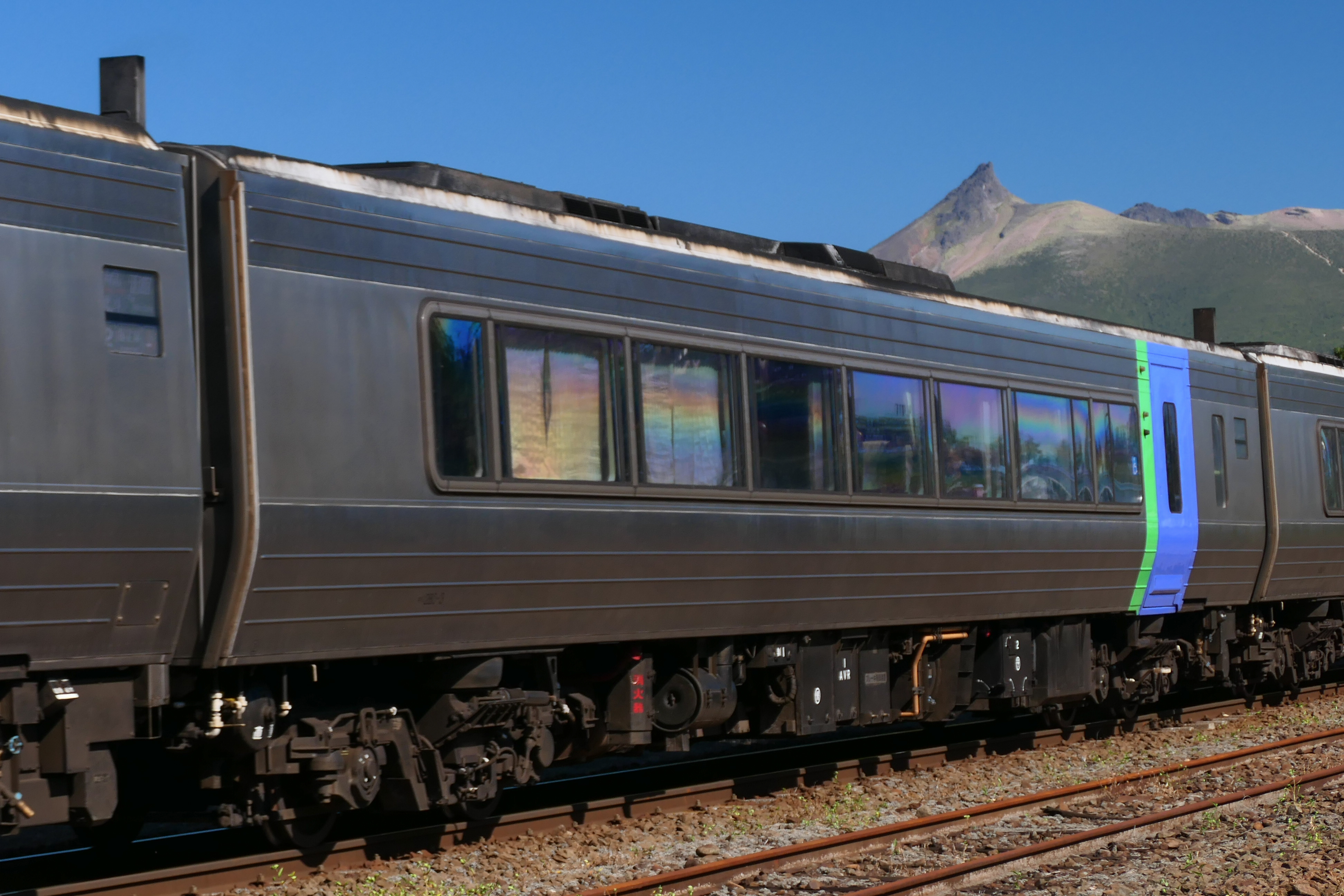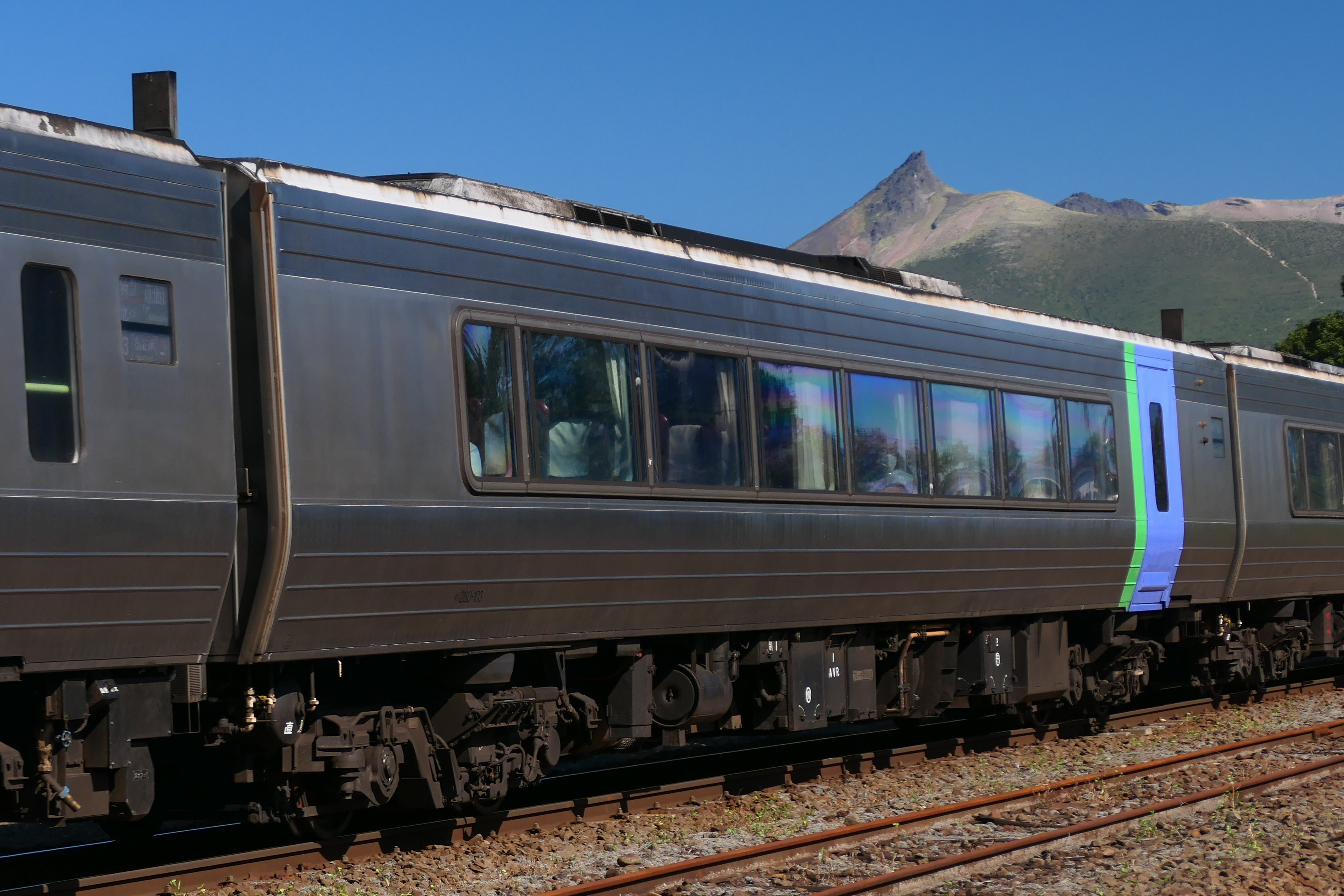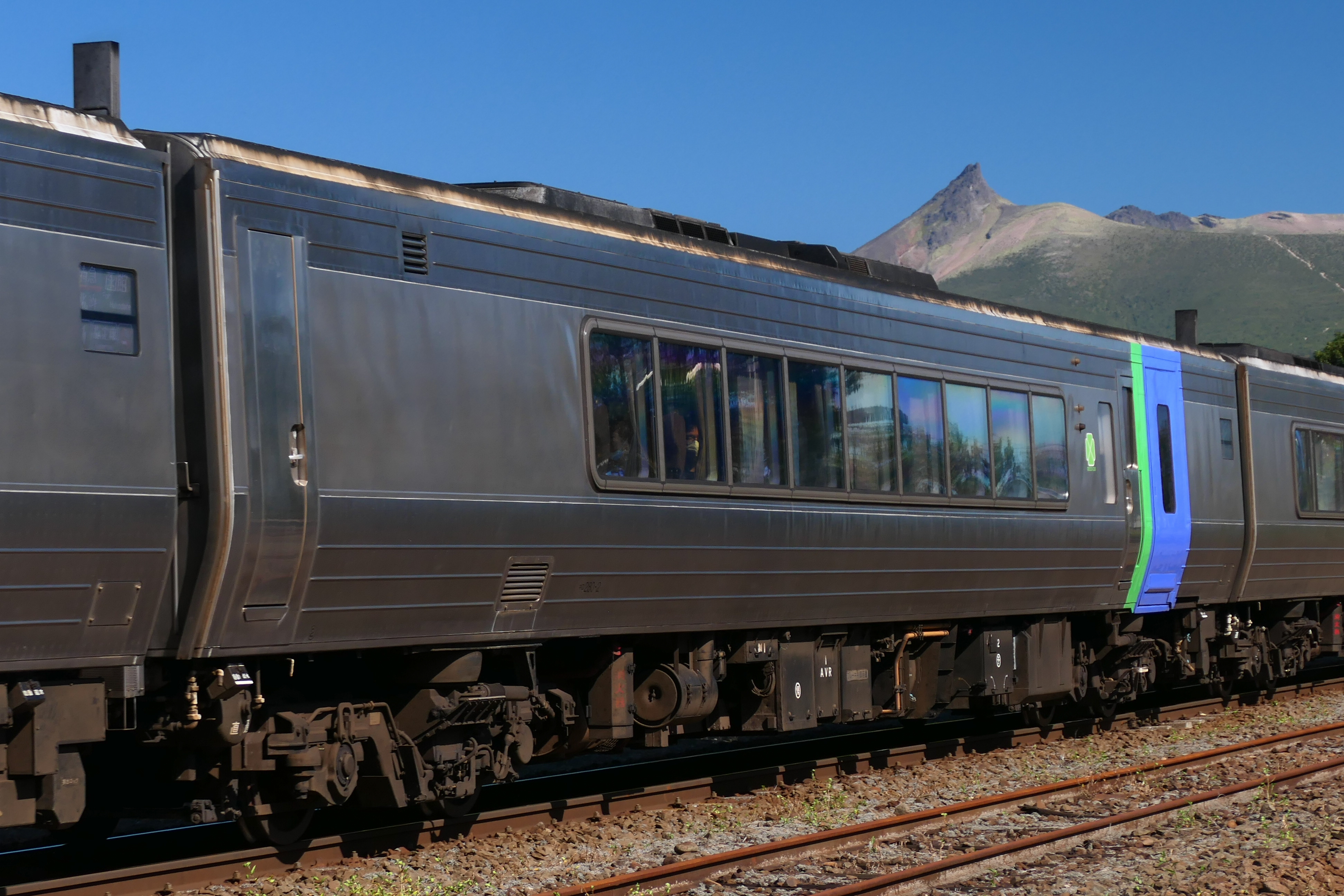KiHa 281 Series on:
[Wikipedia]
[Google]
[Amazon]
The was a tilting diesel multiple unit (DMU) train type operated by
 * Nos. KiHa 281-901–902 (2 vehicles)
Pre-production driving (control) cars built by
* Nos. KiHa 281-901–902 (2 vehicles)
Pre-production driving (control) cars built by
 * No. KiHa 280-901 (1 vehicle)
Pre-production intermediate car built by
* No. KiHa 280-901 (1 vehicle)
Pre-production intermediate car built by
 * Nos. KiHa 281-1–6 (6 vehicles)
Production driving (control) cars built by Fuji Heavy Industries and delivered from 1993. Seating capacity is 48, with toilets.
* Nos. KiHa 281-1–6 (6 vehicles)
Production driving (control) cars built by Fuji Heavy Industries and delivered from 1993. Seating capacity is 48, with toilets.
 * Nos. KiHa 280-1–4 (4 vehicles)
Production intermediate cars built by Fuji Heavy Industries and delivered from 1993. Seating capacity is 51, with wheelchair space,
* Nos. KiHa 280-1–4 (4 vehicles)
Production intermediate cars built by Fuji Heavy Industries and delivered from 1993. Seating capacity is 51, with wheelchair space,
 * Nos. KiHa 280-101–110 (10 vehicles)
Production intermediate cars built by Fuji Heavy Industries and delivered from 1993. Seating capacity is 60, with conductor's compartment, but no toilets.
* Nos. KiHa 280-101–110 (10 vehicles)
Production intermediate cars built by Fuji Heavy Industries and delivered from 1993. Seating capacity is 60, with conductor's compartment, but no toilets.
 * Nos. KiRo 280-1–4 (4 vehicles)
Production Green (first class) cars built by Fuji Heavy Industries and delivered from 1993. Seating capacity is 26, with conductor's compartment, toilets, and a smoking area.
* Nos. KiRo 280-1–4 (4 vehicles)
Production Green (first class) cars built by Fuji Heavy Industries and delivered from 1993. Seating capacity is 26, with conductor's compartment, toilets, and a smoking area.
File:JRH Kiha281-901 Inside.jpg, Original interior
File:JRH Kiha280-3 Inside.jpg, Standard interior
File:JRH Kiro280-2 Inside.jpg, Green car interior
File:JRH Kiha281-901 Inside LED.jpg, Passenger information display
File:JRH Kiha280-3 Inside Aisle.jpg, Passenger passage
File:JRH Kiha280-3 Inside Toilet.jpg, Universal design toilet
File:JRH Kiro280-2 Inside Crew-cabin.jpg, Conductor's room
Green car accommodation is scheduled to undergo a programme of refurbishment.
 The KiHa 281 series entered revenue service from the start of the revised timetable on 1 March 1994. The new tilting trains operated at a maximum speed of , reducing the journey time for the distance between Hakodate and Sapporo to 3 hours, shaving 30 minutes off the journey time for ''Hokuto'' services operated by KiHa 183 series DMUs.
The original "HEAT281" logo on cab sides of the pre-production trains was changed from "Hokkaido Experimental Advanced Train" to "Hokkaido Express Advanced Train" with the arrival of the production cars. This logo was later changed to "Furico 281" to match the style used on the newer
The KiHa 281 series entered revenue service from the start of the revised timetable on 1 March 1994. The new tilting trains operated at a maximum speed of , reducing the journey time for the distance between Hakodate and Sapporo to 3 hours, shaving 30 minutes off the journey time for ''Hokuto'' services operated by KiHa 183 series DMUs.
The original "HEAT281" logo on cab sides of the pre-production trains was changed from "Hokkaido Experimental Advanced Train" to "Hokkaido Express Advanced Train" with the arrival of the production cars. This logo was later changed to "Furico 281" to match the style used on the newer
 On 13 July 2022, JR Hokkaido announced its plans to withdraw the KiHa 281 series from operation and replace the type with the KiHa 261 series. The KiHa 281 series made its final run in regular service on 30 September 2022. Pre-production car KiHa 281-901 was repainted to feature the original livery and "HEAT281" logo in preparation for a chartered final-run train that will run between 22 and 23 October.
On 13 July 2022, JR Hokkaido announced its plans to withdraw the KiHa 281 series from operation and replace the type with the KiHa 261 series. The KiHa 281 series made its final run in regular service on 30 September 2022. Pre-production car KiHa 281-901 was repainted to feature the original livery and "HEAT281" logo in preparation for a chartered final-run train that will run between 22 and 23 October.
JR Hokkaido KiHa 281/283 ''Super Hokuto'' train information
{{JR Hokkaido trainsets 281 series Hokkaido Railway Company Tilting trains Train-related introductions in 1994 281
Hokkaido Railway Company
The is one of the constituent companies of the Japan Railways Group (JR Group), and is often referred to by its official abbreviation: . It operates intercity and local rail services in Hokkaido, Japan. The company introduced Kitaca, a smart ...
(JR Hokkaido) on '' Super Hokuto'' limited express
A limited express is a type of express train or express bus service that stops at fewer locations compared to other express services on the same or similar routes.
Japan
The term "limited express" is a common translation of the Japanese ...
services in Hokkaido
is the list of islands of Japan by area, second-largest island of Japan and comprises the largest and northernmost prefectures of Japan, prefecture, making up its own list of regions of Japan, region. The Tsugaru Strait separates Hokkaidō fr ...
, Japan, from 1994 until 2022. They were the first tilting trains to be operated by JR Hokkaido.
Formations
The fleet of 27 cars was normally formed into seven-car sets for use on '' Hokuto'' (named ''Super Hokuto'' until March 2020)limited express
A limited express is a type of express train or express bus service that stops at fewer locations compared to other express services on the same or similar routes.
Japan
The term "limited express" is a common translation of the Japanese ...
services operating between and , and formations were sometimes lengthened to eight cars during busy periods.
7-car formations
7-car sets were normally formed as follows, with car 1 at the Sapporo end. Car 3 was a Green (first class) car.8-car formations
Sets lengthened to 8 cars were normally formed as follows, with car 1 at the Sapporo end. Car 3 was a Green car.Individual vehicle types
KiHa 281-900
 * Nos. KiHa 281-901–902 (2 vehicles)
Pre-production driving (control) cars built by
* Nos. KiHa 281-901–902 (2 vehicles)
Pre-production driving (control) cars built by Fuji Heavy Industries
, formerly , is a Japanese multinational corporation and conglomerate primarily involved in both terrestrial and aerospace transportation manufacturing. It is best known for its line of Subaru automobiles. Founded in 1953, the company was named ...
and delivered in January 1992. Seating capacity is 48, with toilets.
KiHa 280-900
 * No. KiHa 280-901 (1 vehicle)
Pre-production intermediate car built by
* No. KiHa 280-901 (1 vehicle)
Pre-production intermediate car built by Fuji Heavy Industries
, formerly , is a Japanese multinational corporation and conglomerate primarily involved in both terrestrial and aerospace transportation manufacturing. It is best known for its line of Subaru automobiles. Founded in 1953, the company was named ...
and delivered in October 1992. Seating capacity is 60. The width of the side doors was increased from on the KiHa 281-901–902 cars to .
KiHa 281-0
 * Nos. KiHa 281-1–6 (6 vehicles)
Production driving (control) cars built by Fuji Heavy Industries and delivered from 1993. Seating capacity is 48, with toilets.
* Nos. KiHa 281-1–6 (6 vehicles)
Production driving (control) cars built by Fuji Heavy Industries and delivered from 1993. Seating capacity is 48, with toilets.
KiHa 280-0
 * Nos. KiHa 280-1–4 (4 vehicles)
Production intermediate cars built by Fuji Heavy Industries and delivered from 1993. Seating capacity is 51, with wheelchair space,
* Nos. KiHa 280-1–4 (4 vehicles)
Production intermediate cars built by Fuji Heavy Industries and delivered from 1993. Seating capacity is 51, with wheelchair space, universal access
Ios, Io or Nio (, ; ; locally Nios, Νιός) is a Greek island in the Cyclades group in the Aegean Sea. Ios is a hilly island with cliffs down to the sea on most sides. It is situated halfway between Naxos and Santorini. It is about long an ...
toilets, and a telephone.
KiHa 280-100
 * Nos. KiHa 280-101–110 (10 vehicles)
Production intermediate cars built by Fuji Heavy Industries and delivered from 1993. Seating capacity is 60, with conductor's compartment, but no toilets.
* Nos. KiHa 280-101–110 (10 vehicles)
Production intermediate cars built by Fuji Heavy Industries and delivered from 1993. Seating capacity is 60, with conductor's compartment, but no toilets.
KiRo 280-0
 * Nos. KiRo 280-1–4 (4 vehicles)
Production Green (first class) cars built by Fuji Heavy Industries and delivered from 1993. Seating capacity is 26, with conductor's compartment, toilets, and a smoking area.
* Nos. KiRo 280-1–4 (4 vehicles)
Production Green (first class) cars built by Fuji Heavy Industries and delivered from 1993. Seating capacity is 26, with conductor's compartment, toilets, and a smoking area.
Interior
Passenger seating used the same rotating/reclining seats as used on the 785 series EMUs. Seating is arranged 2+2 abreast in standard class and 2+1 abreast in Green class.History
Pre-production sets
Two pre-production cars, KiHa 281-901 and KiHa 281-902, were delivered fromFuji Heavy Industries
, formerly , is a Japanese multinational corporation and conglomerate primarily involved in both terrestrial and aerospace transportation manufacturing. It is best known for its line of Subaru automobiles. Founded in 1953, the company was named ...
in January 1992 for evaluation and testing. A pre-production intermediate car, KiHa 280-901, also built by Fuji Heavy Industries, was delivered in October 1992 to form a 3-car set. The first two cars delivered used the same roller-tilting mechanism on the bogies as used on the earlier JR Shikoku 2000 series DMUs, whereas the third car delivered used a bearing-guide system. The pre-production 3-car train underwent test-running to evaluate the two different systems in the harsh winter conditions of Hokkaido. The later bearing-guide tilt mechanism proved superior, and this system was used on subsequent production trains delivered from 1993.
Entry into service
 The KiHa 281 series entered revenue service from the start of the revised timetable on 1 March 1994. The new tilting trains operated at a maximum speed of , reducing the journey time for the distance between Hakodate and Sapporo to 3 hours, shaving 30 minutes off the journey time for ''Hokuto'' services operated by KiHa 183 series DMUs.
The original "HEAT281" logo on cab sides of the pre-production trains was changed from "Hokkaido Experimental Advanced Train" to "Hokkaido Express Advanced Train" with the arrival of the production cars. This logo was later changed to "Furico 281" to match the style used on the newer
The KiHa 281 series entered revenue service from the start of the revised timetable on 1 March 1994. The new tilting trains operated at a maximum speed of , reducing the journey time for the distance between Hakodate and Sapporo to 3 hours, shaving 30 minutes off the journey time for ''Hokuto'' services operated by KiHa 183 series DMUs.
The original "HEAT281" logo on cab sides of the pre-production trains was changed from "Hokkaido Experimental Advanced Train" to "Hokkaido Express Advanced Train" with the arrival of the production cars. This logo was later changed to "Furico 281" to match the style used on the newer KiHa 283 series
The is a tilting train, tilting diesel-hydraulic diesel multiple unit, multiple unit (DMU) train type operated by Hokkaido Railway Company (JR Hokkaido) on limited express services in Hokkaido, Japan, since 1997. They were based on the KiHa 281 ...
trains.
Laurel Prize
The KiHa 281 series was awarded theLaurel Prize
The is an award presented annually in Japan since 1961 by the Japan Railfan Club. It is awarded for railway vehicles that entered service in the previous year and voted by the selection committee as having the most outstanding functional and des ...
in 1995 for its outstanding functional and design features.
Withdrawal
 On 13 July 2022, JR Hokkaido announced its plans to withdraw the KiHa 281 series from operation and replace the type with the KiHa 261 series. The KiHa 281 series made its final run in regular service on 30 September 2022. Pre-production car KiHa 281-901 was repainted to feature the original livery and "HEAT281" logo in preparation for a chartered final-run train that will run between 22 and 23 October.
On 13 July 2022, JR Hokkaido announced its plans to withdraw the KiHa 281 series from operation and replace the type with the KiHa 261 series. The KiHa 281 series made its final run in regular service on 30 September 2022. Pre-production car KiHa 281-901 was repainted to feature the original livery and "HEAT281" logo in preparation for a chartered final-run train that will run between 22 and 23 October.
References
External links
JR Hokkaido KiHa 281/283 ''Super Hokuto'' train information
{{JR Hokkaido trainsets 281 series Hokkaido Railway Company Tilting trains Train-related introductions in 1994 281